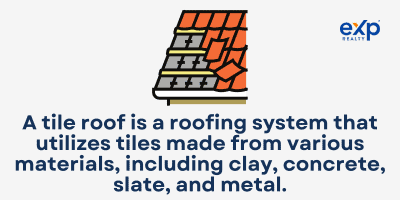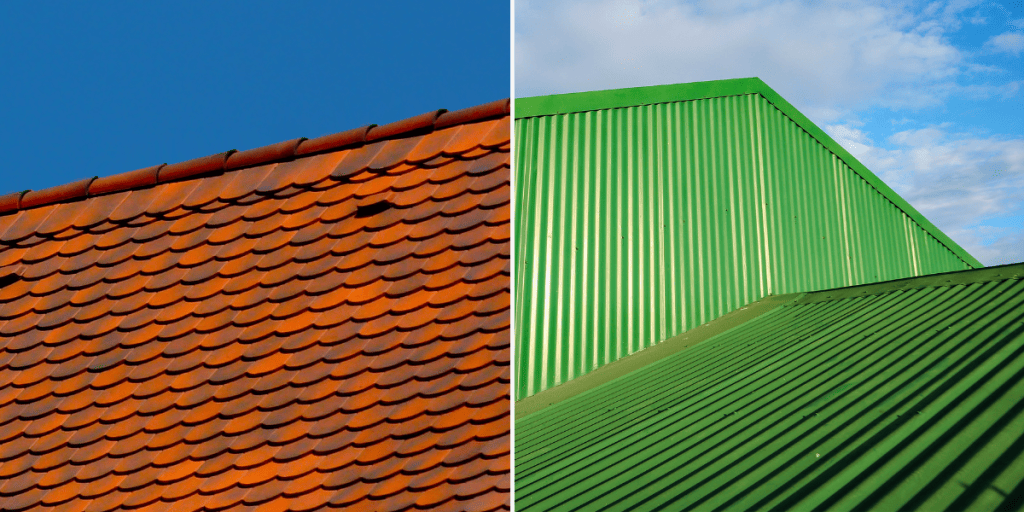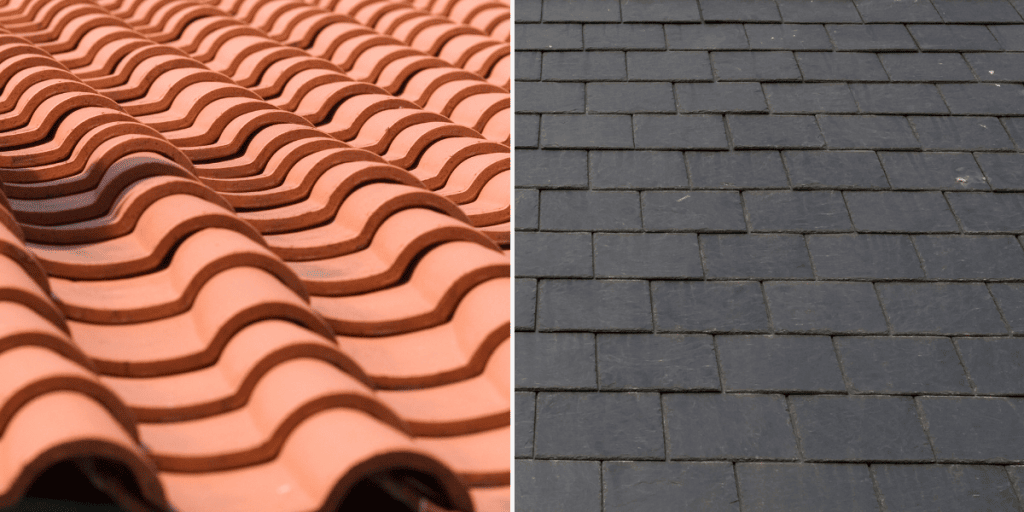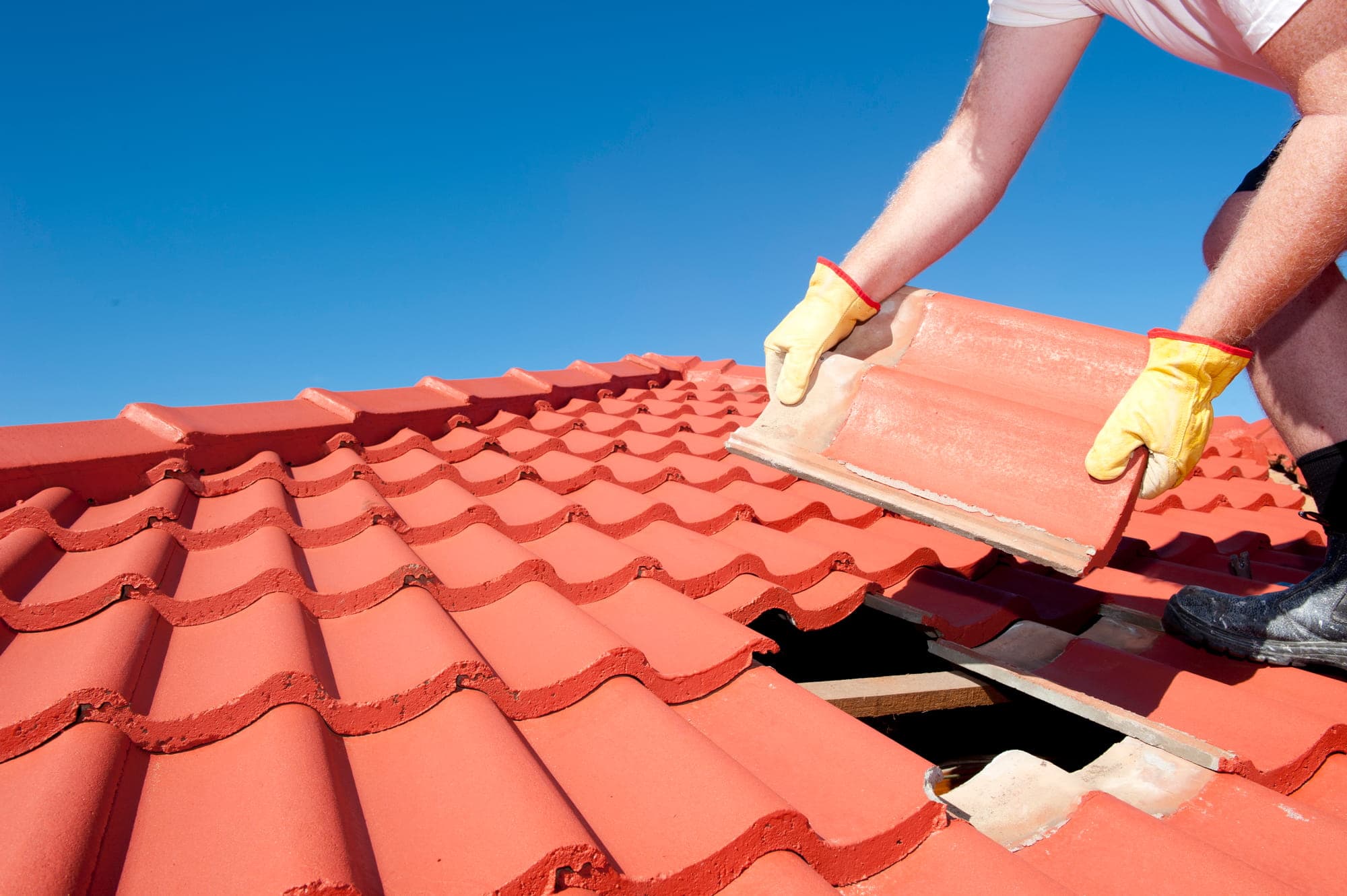When choosing a roof for your home, various factors include longevity, maintenance, cost, and aesthetic appeal. One popular option that ticks all these boxes is a tile roof.
This guide explores what tile roofs are, the different types of tiles used, their benefits, and how they compare to other roofing materials.
So if you’re considering a new roof for your home, want to purchase a property with this type of roofing, or just curious about the different options out there, it’s worth considering whether a tile roof might be the right fit for you.
What Is a Tile Roof?

A tile roof is a roofing system that utilizes tiles made from various materials, including clay, concrete, slate, and metal. With a rich history dating back to ancient civilizations like the Greeks and Romans, tile roofs have proven their worth in terms of durability and aesthetic appeal.
Notably, clay tiles (especially the popular Spanish tile and French tile), concrete tiles, and slate tiles offer an array of colors and styles, ranging from the traditional barrel tile or mission tiles to modern flat tile designs.
This range of tile types can meet a variety of architectural styles, ensuring a perfect fit for every home. Concrete and clay tile roofing are among the most prevalent tile roofs due to their durability, weather resistance, fire resistance, and energy efficiency.
Pros of Tile Roofs
Roof tiles have many advantages, and the following are the most prominent ones.
Longevity and Durability
One of the main benefits of tile roofs is their longevity. A tile roof can last several decades with proper installation and minimal maintenance. Unlike wood shakes or cedar shake roofs, the sturdy individual tiles resist harsh weather conditions and are not susceptible to insect damage or rot.
In addition, when roof repair is necessary, replacement tiles can easily substitute for a broken tile without needing to replace the entire roof.
Energy Efficiency and Insulation
Tile roofs are energy-efficient roofing materials. Their inherent thermal resistance and ventilation properties help to maintain stable indoor temperatures, reducing energy costs.
They are ideal for both hot climates like Central and South Florida and cold climates with freeze-thaw cycles, where temperature swings can be extreme. Solar and solar roof tiles also offer a green energy solution for environmentally conscious homeowners.
Aesthetic Appeal and Customization Options
Tile roofs have a distinct, high-end look that enhances a home’s curb appeal. From the variety of colors and styles to custom roof tiles, homeowners can choose a tile material and style that complements their home’s architectural designs.
Clay tiles, for example, have an organic, earthy appearance, while metal tiles can offer a more modern, sleek look. With the wide range of color options, finding a tile roof that suits your style and preference is easy.
Fire and Weather Resistance
Tile roofs are Class A fire-rated, meaning they provide the highest protection against fire. Additionally, they withstand extreme weather conditions, such as high winds, hail, and heavy rain. Some tile roofs have been known to resist winds up to 150 miles per hour. This resistance level makes tile roofs ideal for locations prone to natural disasters.
Tile roofs also offer a range of other benefits, such as resistance to mold and insect damage. Moreover, they’re eco-friendly, as most tiles are made from natural materials and can be recycled at the end of their life cycle.
Disadvantages of Tile Roofs
While tile roofs offer numerous benefits, homeowners should be aware of potential drawbacks before deciding.
Initial Installation Costs
Tile roofs typically cost more than popular roofing materials like asphalt shingles or wood shakes. The average cost per square foot can vary widely depending on the type of tile, the complexity of the roof, and labor costs. However, this initial investment can be justified when considering the durability and long lifespan of tile roofs.
Fragility and Potential for Breakage
Despite their durability, individual tiles can be fragile and break under heavy foot traffic or when impacted by falling objects. Homeowners should limit foot traffic on tile roofs and have a professional roofing contractor perform maintenance and inspections.
Weight and Structural Considerations
Tile roofs are heavy, especially concrete or clay tile roofs. A square of clay or concrete tiles can weigh up to 1,000 pounds per square (an area equal to 100 square feet), requiring roof reinforcement before installation in some cases. Homeowners should ensure their home’s structure can support the weight of a tile roof.
Comparing Tile Roofs to Asphalt Shingle Roofs

Asphalt shingle roofs are a common and cost-effective roofing solution made from a fiberglass base topped with asphalt and mineral granules.
Compared to tile roofs, asphalt shingles may have a shorter lifespan, with an average of 20 years compared to the 50-100 years of tile roofs. This shorter lifespan may result in more frequent replacement costs.
Regarding energy efficiency, tile roofs typically outperform asphalt shingles due to their better insulation and thermal resistance properties. Moreover, tiles are more eco-friendly, made from natural materials, and recyclable, whereas asphalt shingles are petroleum products.
However, asphalt shingles come in various colors and styles and are lightweight, eliminating the need for additional structural reinforcements. Also, asphalt shingles are easy to install and repair, usually requiring lower labor costs than tile roof installation or repair.
Comparing Tile Roofs to Metal Roofs

Metal roofs, crafted from steel, aluminum, or copper, are renowned for their longevity, durability, and resistance to elements.
Both metal and tile roofs are durable and long-lasting, with metal roofs potentially lasting up to 70 years. Like tile roofs, metal roofs also offer excellent fire and weather resistance. However, metal roofs are much lighter than tile roofs, eliminating the need for structural reinforcements.
When it comes to energy efficiency, both roofing types perform well. Metal roofs, especially when treated with a reflective coating, can reflect solar heat, helping to reduce cooling costs in hot climates.
Noise can concern metal roofs, especially during rain or hail. In contrast, tile roofs are typically quieter.
Comparing Tile Roofs to Slate Roofs

Slate roofs, crafted from natural slate tiles, are recognized for their exceptional durability, timeless beauty, and long lifespan.
Both slate and tile roofs are known for their durability and long lifespan, with both capable of lasting up to 100 years or more with proper maintenance. However, slate roofs may require less maintenance than tile roofs, as they’re less prone to breakage.
Aesthetically, slate offers a classic, refined look that adds to the curb appeal and value of the home. On the other hand, tile roofs offer a broader range of styles and colors, allowing homeowners to customize their roofs to their personal tastes and home’s architectural style.
Regarding weight, both slate and tile roofs are heavy, potentially necessitating roof reinforcement before installation. Slate is particularly heavy, with some types requiring up to 1,500 pounds per square of structural support.
Is a Tile Roof Right for You?
Several factors should be considered when deciding whether a tile roof is right for your home.
- Budget and Long-term Investment: While the upfront costs of a tile roof can be higher than other roofing materials, its long lifespan and durability can make it a cost-effective choice in the long run.
- Climate and Weather Conditions: Tile roofs perform well in various climates and offer excellent resistance to fire and harsh weather conditions. They are particularly well-suited to hot climates but can also perform well in cold climates with freeze-thaw cycles.
- Home Style and Architectural Compatibility: With a range of styles and colors available, tile roofs can enhance any home’s architectural style. Whether you prefer the traditional look of Spanish tile or the sleek design of flat tile, there is a tile roof to suit your style.
Other notable factors include:
- Your home’s structural capacity to support the weight of a tile roof
- The need for maintenance and potential for repair costs
- Your preference for sustainable, eco-friendly materials.
Key Takeaways
Tile roofs offer a unique combination of longevity, durability, energy efficiency, and aesthetic appeal. These attributes make them a popular choice among homeowners seeking a roofing system that protects their home and enhances its beauty and value.
While the initial costs can be higher than other roofing types, the long lifespan of tile roofs can make them a sound long-term investment. In addition, their resistance to fire, insects, and harsh weather conditions can provide additional peace of mind.
Remember, a quality roof protects your property and contributes to its curb appeal and value. Therefore, choosing the right roof is crucial. If you’re looking for properties with a tile roof, contact a local eXp Realty agent today to help you find the perfect fit.
FAQs: Tile Roof
If you’re considering changing your roof, we wrote the following section to help you out.
Is a tile roof better than a shingle roof?
Tile roofs outlast shingle roofs in lifespan and durability, though they come with higher initial costs. Tiles are also more eco-friendly and aesthetically diverse.
How long will a tile roof last?
With proper maintenance and installation, tile roofs can last over 50 years. Some high-quality tile roofs can even last up to 100 years or more.
What is roof tile called?
Roof tiles are called by their material (concrete, clay, slate, etc.) or style (barrel, flat, Spanish, French, etc.).
What are the common problems with tile roofs?
Tile roofs can be prone to cracking and breaking, leaks beneath tiles, and color fading. Regular maintenance and inspections can mitigate these issues.
Do tile roofs keep a house cooler?
Yes, tile roofs are excellent insulators and help keep the house cool in hot climates, reducing energy costs for air conditioning.
What is the best roof for a residential house?
The best roof depends on the home’s architectural style, climate, the homeowner’s budget, and preference. Both tile and shingle roofs have their merits.
How do you walk on a tiled roof?
Walking on a tile roof should be done carefully to avoid breaking tiles. It’s best to walk on the lower third of the tiles, or hire a professional.
Do tile roofs leak?
Any roof can leak if improperly installed or maintained. Regular inspections and immediate repair of broken tiles can prevent leaks in tile roofs.
What sits under roof tiles?
Under roof tiles is an underlayment, a protective material that provides a secondary barrier against water infiltration.
Why do California houses have tile roofs?
Tile roofs are popular in California due to their fire resistance, excellent performance in hot climates, and the Spanish-influenced architectural style of many homes.
Are tile roofs hurricane proof?
While no roof is entirely “hurricane-proof,” tile roofs can resist high winds up to 150 miles per hour, making them a good choice in hurricane-prone areas.





